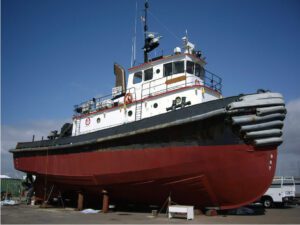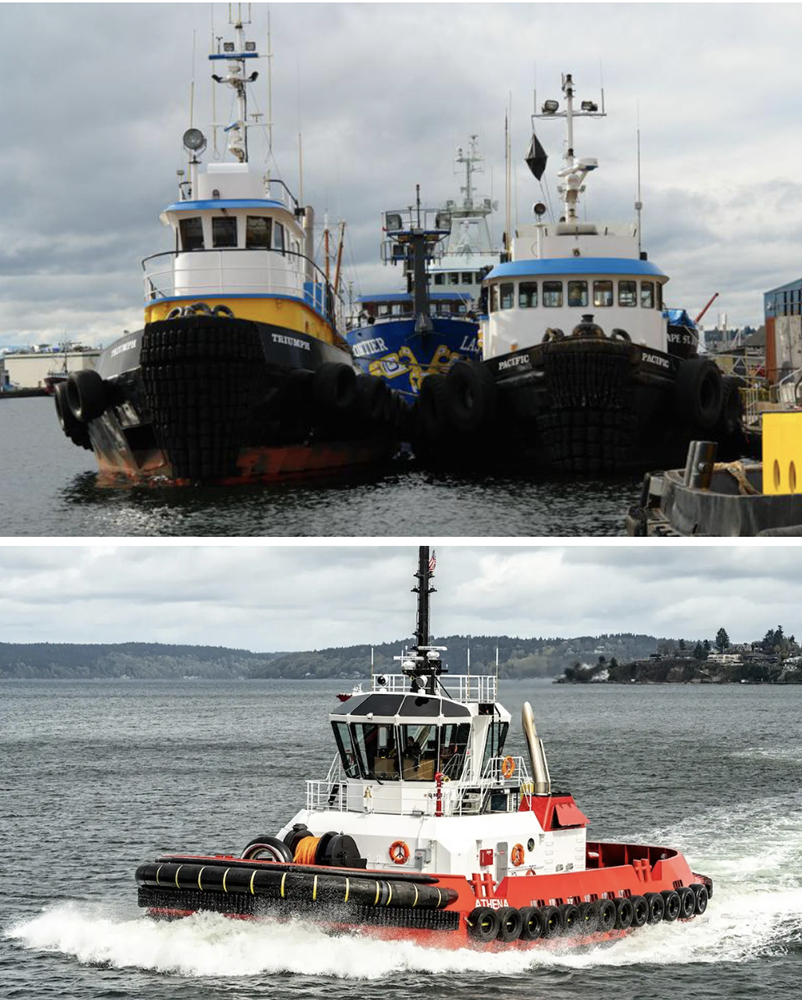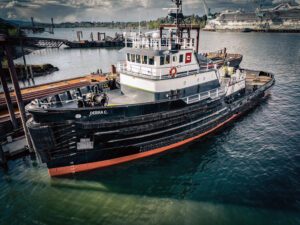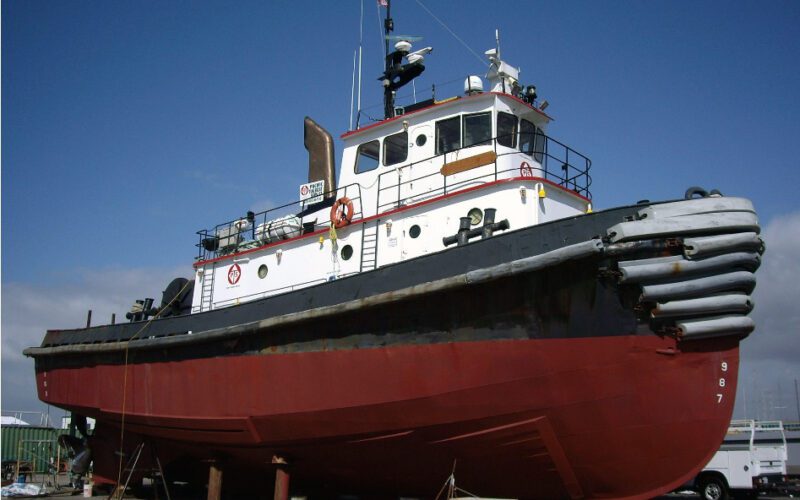
Maritime shipping volumes stalled at some West Coast ports in 2022, but even still, there remained a large need for ocean and coastal towing services to guide commercial vessels of all sizes to shore.
In fact, according to an analysis released in March by the global firm Technavio Research, the tugboats services market is expected to grow by $2.42 billion between now and 2026, with 33% of that growth originating in North America.
The report, titled “Tugboats Services Market by Application and Geography—Forecast and Analysis 2022-2026,” states that the market will witness a year-over-year growth of 14.24% in 2022 and a compound annual growth rate of 14.64% during the forecast period.
So even if maritime commerce is experiencing a slight downturn on the West Coast, the want and need for tugboat services is expected to remain strong.
And many tugboat owners and operators from Washington to California and in Alaska and Hawaii know this, as a number of them have been busy investing in equipment and technology.
Here’s a look at what some were up to in 2022.
PACIFIC MARITIME GROUP
Pacific Maritime Group, a San Diego-headquartered company that offers numerous services, including ocean towing and harbor/inland towing, has a fleet of more than a dozen tugs.
In the spring, the company began the process of repowering the JM Hidalgo, an 80-foot ocean towing vessel that had been operating with 1100 hp Caterpillar 3508 engines installed in 2006.
The Hidalgo, built in 1971 and rebuilt and repowered in 2006, is a 73.6-foot-by-25-foot-by -9..7-foot model bow ocean tug. She is named after U.S. Marine Corps Sgt. Major Juan Hidalgo Jr., a combat veteran who once served as the command sergeant major of the U.S. military prison in Guantanamo Bay, Cuba.
As part of a state effort to curb air pollution, the vessel’s new engines are rated by the California Air Resources Board as Tier 3 compliant. The new engines are rated at 1100hp.
“Shiny and new, this 49-liter Mitsubishi S12R engine is ready for work,” PMG said in a statement.
“Changing engines is not like swapping batteries in a flashlight. The engines literally weigh tons. In the case of the Hidalgo, we elected to cut a hole in the side to allow access to the engine space,” PMG explained. “The exhaust stacks, mufflers and piping were removed, followed by the Caterpillar 3508 engines.”
Once the engine room was empty, the real work began. Structural members of the tug frame had to be modified to accept the new engines, and the old wiring and instrumentation were removed to install new technology.
“Careful planning must be made,” the company said.
PMG said that it used the opportunity to upgrade other systems of the tug and to service equipment.
The firm also added to its Mitsubishi fleet in 2022 by installing a new S16R-Y3MPTAW, 1675hp engine for the Blarney, and another pair of S12R-Y3, 1100hp engines in the tugboat Bass.

WESTERN TOWBOAT
Through most of 2022, Seattle-based Western Towboat Co. performed a rebuild of one of its older tugs, the Pacific. According to the company, a completely new stern has been added to the tug, with various upgrades made to the interior.
In February, company Vice President Russell Shrewsbury told the digital edition of industry publication Marine Log that Western Towboat was about 40% complete on hull No. 20, which is the company’s eighth Titan Class tug. It is powered by C175 Caterpillar engines and Schottel SRP 490s thrusters.
The Pacific, built in 1969, is a 70-foot-long, 24-foot-wide tugboat with a nine-foot depth and a weight of 96 gross tons. She has a fuel capacity of 19,000 gallons.
The company anticipates that work on the tug will be finished in the first quarter of 2023.
“After that, we plan to build our own dry dock,” Shrewsbury told Marine Log. “The logistics of building that in our yard is going to be the hard part due to our small footprint, so we may be reaching out for some help to construct the dock sooner than later as our need for it grows by the day.”
CROWLEY MARITIME
In April, Crowley Maritime, which is based in Florida but has a large presence on the West Coast, took delivery of Athena, its fourth and most powerful Tier IV ship-assist-and-harbor escort tugboat.
Operating on biofuel, the vessel’s fuel-efficiency and lower carbon footprint results from a pair of Caterpillar Marine 3516 Tier IV-compliant engines that meet federal mandates and California environmental regulations.
The 77-foot vessel’s engines can result in lower greenhouse gas emissions while achieving a power output of nearly 6,800hp and 96 tons of bollard pull, according to Crowley.
“We are proud to add another powerful vessel to our Tier IV fleet,” Crowley Shipping Vice President Paul Manzi said in a statement. “Joining sister Tier IV tugs Hercules and Apollo as well as our tug Valor, Athena further exemplifies Crowley’s commitment to sustainable performance for customers, advancing our progress to reduced emissions and a smaller carbon footprint.”
Serving the Pacific Northwest out of Puget Sound, Wash., Athena—built by Portland-based Diversified Marine Inc. and chartered from Longview, Wash.-based Brusco Tug & Barge—complies with U.S. EPA Tier IV pollution control technology criteria, according to Crowley.
The vessel is outfitted with remote monitoring for increased vessel efficiency and data interchange.
“Athena is going to be a head turner in the Puget Sound,” Diversified Marine Vice President Frank Manning said at the time of its April debut. “We appreciate the partnership between Brusco Tug & Barge and Crowley and look forward to continuing to move the needle in tug performance, technology and sustainability.”
FOSS MARITIME
In August, a Foss Maritime tug based in San Francisco, the Rachael Allen, received approval from the American Bureau of Shipping to use an autonomous navigation and enhanced situational awareness system.
The ship-assist tug is fitted with Sea Machines’ SM300 autonomous and remote navigation suite.
The shipping bureau said that Sea Machines’ autonomous system underwent a series of rigorous product reviews to prove that the technology met ABS requirements for the use of such systems aboard vessels. The SM300 system also assists with station-keeping and is capable of interfacing with Kongsberg-MTU propulsion systems.
“Autonomous technology continues to advance at pace and ABS is committed to supporting its safe adoption by the industry,” ABS Senior Vice President Patrick Ryan said. “We are proud to add this project to the list of pioneering initiatives … that are gradually realizing the potential of autonomous operations for the industry.”
Throughout the approval process, ABS reviewed numerous documents for Sea Machines, including software test plans and concept of operations materials for the Rachael Allen. In such reviews, ABS seeks to identify potential design risks or issues that may result in substantial change in direction in the project by evaluating the design approaches, rules, regulations and types of calculations presented.
“Sea Machines worked closely alongside ABS and Foss to yield this most recent approval, which moves our entire industry yet another step closer to widespread adoption of autonomous marine technologies,” Sea Machines CEO Michael G. Johnson said.
Autonomous solutions are increasingly finding their way into the workboat world, including select applications for tugboats. Keppel O&M and ABB recently tried an autonomous system aboard a tug in Singapore’s busy anchorage, testing its responses in complex collision-avoidance scenarios. Crowley’s future electric tug, the eWolf, will be delivered with an ABB autonomous navigation system. And last year, Sea Machines conducted a 1,000-mile autonomous tug voyage in Germany and Denmark, the first trip of its kind; the vessel was overseen remotely from Boston.

CURTIN MARITIME
In June, Long Beach, Calif.-based boat repair and tugboat operator Curtin Maritime welcomed a new vessel to its growing fleet. The tugboat, the Debra C., measures 144-foot by 34-foot by 13.7-foot. The tug, which was built in 1971, has two EMD 16-645 E2 engines with 3,900hp.
Other specifications include two John Deere 6068-75 with Marathon 99kW generators; a Markey TDSD 36 double drum tow winch with cathead and hydraulic tugger, and a 2-1/4-inch by 2,600-foot drum. It has a fuel capacity of 146,000 gallons.
“Massive shoutout to Cameron Newett, Chris Sumpter, Angelo Luhrsen, Luca Luhrsen, Will Borzi and the entire shipyard crew,” the company said in a statement. In 14 days, these hardworking folks turned the Debra C. from an eyesore into some serious eye candy.”
Curtin Maritime, which currently has 15 tugboats operating on the West Coast, moved in the fall to a new headquarters at the northwest end of Pier T at the Port of Long Beach.

